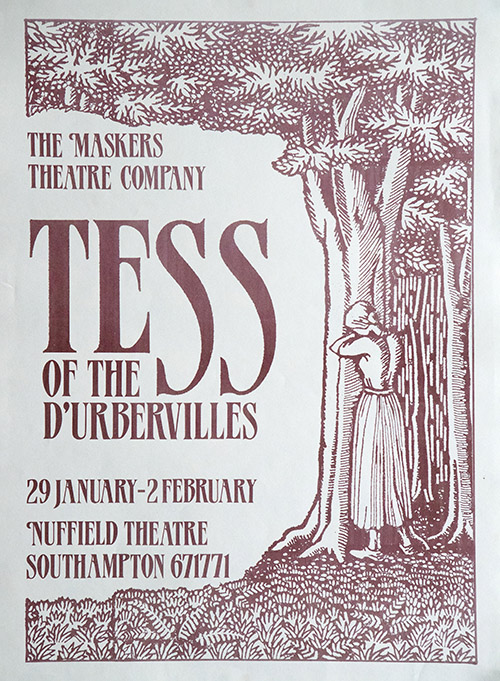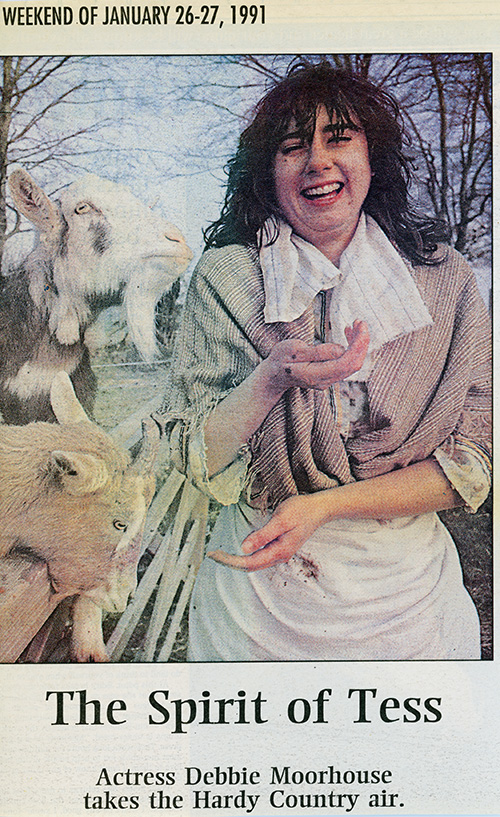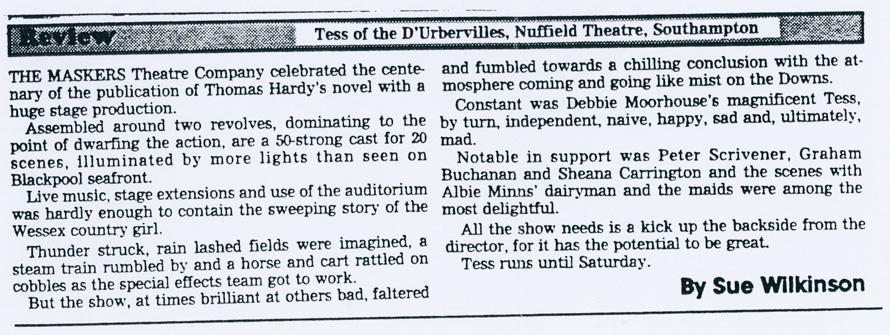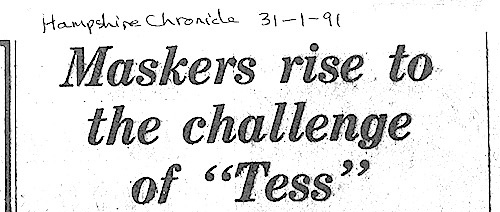Nuffield Theatre
on29th January to 2nd February 1991

The twice-married Hardy is renowned for having an eye for the ladies, and must have greatly enjoyed the surge of interest from leading ladies from the London stage, anxious that he should adapt the play as a starring vehicle for them.
He prepared a script but it was never performed - until in 1908 the Dorchester Debating Literary and Dramatic Society performed an adaptation of The Trumpet Major. This started an annual tradition, which continued until 1924 when the Hardy Players, as they were by then called, asked to do Tess of the d’Urbervilles. The lead was taken by the beautiful Gertrude Bugler, the daughter of a Dorchester confectioner, who had first caught Hardy’s eye when she starred, at the age of 17 in 1913, in The Woodlanders, to acclaim from the London critics, and with her photograph in the Daily Mail.
It is recorded that Hardy spent more time backstage than in the auditorium during ‘Tess’, and following the production (in Weymouth and Dorchester) the manager of the Haymarket Theatre in London wrote to ask if Gertrude Bugler would play Tess with a professional cast at the Theatre.
Terms, salaries and rehearsal times were agreed; Hardy wrote a new prologue scene and became highly excited at the thought of going to London. Then Florence, his wife, intervened, sending telegrams, letters and calling in person on Gertrude Bugler begging her to give up the idea; she seemed certain that Hardy - who was now 85 years old - was planning on elopement! Gertrude Bugler, by now 29 years old, found the situation alarming and withdrew from the production.
In 1929, the year after Hardy died, Gertrude Bugler played with great success in a revival at the Duke of York’s - with her name in lights as ‘Thomas Hardy’s Own Tess’.
Gertrude Bugler still lives in Weymouth, now 94 years old.

In Victorian times it was customary for a new book to be published first in serial form in one of the many weekly magazines that then flourished, and Hardy’s popularity was based on the wide audience that these publications provided. In June 1887 he signed a contract worth £1,000 with a newspaper syndicate, Tillotson & Son of Bolton, for the serial rights to his next novel. The first ideas he noted down formed the basis of Jude the Obscure, actually published after Tess; but a number of family anecdotes developed into the d’Urberville story - particularly that of Mary Head, his grandmother, who lived near Reading and bore an illegitimate baby by one John Reed, who must have been a man of standing because the child carried his name. Like Tess, she was remanded in custody for three months under threat of hanging (for stealing a copper kettle, but she was discharged for lack of evidence).
Hardy sent the first portion of the manuscript to the publishers - at that stage called ‘Too Late, Beloved’ - in September 1889. They immediately returned it, saying that a story about a raped village maiden was not a fit subject for their readers; the contract was cancelled and the fee returned.
In October Hardy sent the manuscript to Murray’s Magazine who also rejected it, the editor claiming, ‘I believe it is quite possible and very desirable for women to grow up and pass through life without the knowledge of immoral situations and their tragedies’.
Further rejections followed, but Hardy continued work on the manuscript. Interestingly, the name he chose at first was Love; then Cis, Sue and Rose-Mary, before settling on Tess.
So, after a whole year’s work, Hardy had a story which seemed unsaleable. Eventually The Graphic agreed to serialise a heavily censored version - no mention of the rape or the illegitimate child, and Angel Clare was not allowed to carry Tess and the dairymaids through the flooded lane - he had to push them in a wheelbarrow!
In 1891 the unexpurgated book was published, and despite the reaction of some critics it produced heated discussion over the tea cups and in the pubs and won considerable popular acclaim, generally acknowledging it to be Hardy’s finest book.

| The Cast | |
| John Durbeyfield | Graham Buchanan |
| Parson Tringham & Narrator | David Pike |
| Mrs Rolliver | Philippa Taylor |
| Joan Durbeyfield | Sheana Carrington |
| Tess Durbeyfield | Debbie Moorhouse |
| Alec Stoke d’Urberville | Peter Scrivener |
| Elizabeth, a maid | Maria Hutchings |
| Mrs Stoke d’Urberville | Jenni Watson |
| Reuben Dewy | Kevin Mitchell |
| Abraham Durbeyfield | Dominic O’Farrell |
| Vicar | Kevin Mitchell |
| Mr Crick (Dairyman) | Albert Minns |
| Mrs Crick | Christine Baker |
| Jonathan Kail | Andrew Easton |
| Izz Huett | Karen Upfield |
| Retty Priddle | Hazel Burrows |
| Marian | Angela Stansbridge |
| Liddy Smallbury | Anya Cook |
| Angel Clare | Steve Clark |
| Rev. Clare | Ken Hann |
| Mrs Clare | Mollie Manns |
| Rebecca Spinks | Brenda Atkinson |
| Maryann Money (a Housekeeper) | Sonia Morris |
| Henery Fray | Robbie Carnegie |
| Farmer Groby | Neville Green |
| Liza Durbeyfield | Emma Grace |
| Gabriel Oak | Bruce Atkinson |
| Mrs Brooks (Landlady of The Herons) | Jean Durman |
| Mr Blagdon - her gardener | Mike Turner |
| Sgt. Troy (a Policeman) | Graham Hill |
| Joseph Poorgrass | Rob Robinson |
| Laban Tall | Chris Stockton |
| Matthew Moon | David Gates |
| Fancy Day | Pam Simpson |
| Ann Dewy | Jane Royle |
| Fanny Coggan | Jan Ward |
| Beth Clark | Julie Zillwood |
| Ruth Wetherbury | Angela Mackie |
| Patience Penny | Nichola Horne |
| Hope Durbeyfield | Amy Stansbridge or Katie Ward or Susannah Lawther |
| Cain Durbeyfield | Tom Stansbridge or Nicholas |
| For the Maskers | |
| Written and directed by | Michael Patterson |
| Production Assistant | Jan Ward |
| Stage Manager | Belinda Drew |
| Technical Coordinator | Ron Tillyer |
| Set Design | John Carrington |
| Construction Team | Chris Finbow, Edwin Beecroft, Geoff Cook, Brian Langford, Kevin Mitchell, Pam Simpson |
| Lighting Design | Clive Weeks |
| Assisted by | Anthony Baldery, Angie Burt, Scott Chapman, Sue Coleman, Stuart Cross, Faith Emmett, Dave King, Ali Mountford, Adrian Plaw |
| Sound | Lawrie Gee, Pat Sawyer |
| Special Effects | Tony Lawther, Ron Tillyer |
| Properties | Ella Lockett, Dawn Finbow, Sheana Carrington, Nichola Horne, Sonia Morris, Rob Robinson, Jan Ward |
| Wardrobe | Hazel Burrows, Angela Stansbridge, Helen Wheeler and members of the cast |
| Make-up Co-ordinator | Graham Buchanan |
| Publicity/Posters | Michael Patterson, Jan Ward, Ken Spencer, Edwin Beecroft |
| Choreographer | Brenda Bennett |
Musicians from ‘The Madding Crowd’ |
Pat Guy, Gordon Thick, Caroline Humphreys, Brian Hodgson, Peter Hackston, Sarah Lewin, Brenda Grimshaw, John Martin, Mike Bailey |
Thomas Hardy’s father and grandfather, with other relations, made up the village and church West Gallery bands of Stinsford and Puddletown from about 1770 to 1850. Young Thomas probably never played his fiddle with these bands officially, but Under the Greenwood Tree would not have been possible without his close knowledge of them. The village bands and choirs were suppressed by the Victorian reformers, and the last handful died out in the 1930’s.
The Madding Crowd, members of whom open the show, are a band and choir of about 25 people from South Hampshire, formed to rescue and perform the repertoire of the village bands and choirs, drawing on manuscripts and printed books. Since the first concert in 1975, over 200 hymns, anthems, psalms, secular songs, marches and dances have been researched.
All other music used in the show is by English composers, most of them contemporary with Thomas Hardy - including Edward Elgar, Gerald Finzi, Ralph Vaughan Williams and Michael Tippet.


A large press special. Click below to view.
Some Notes by the Director
Hardy was a man torn between two worlds - the deeply entrenched strength of his family roots in Dorset, contrasting with his involvement in fashionable and aristocratic London society where he was feted as the most outstandingly successful novelist of his day. This schizophrenic situation mirrored the inner conflictsof his mind that were both the source of his genius as a novelist and the cause of much misunderstanding about his personal life which still persists today.
To clear away some of the confusion of legend, I thought you might be intrigued, as I have been, by some aspects of the true facts; Hardy himself propagated much of the confusion by recording events in the way he wished them to be seen, often suppressing the reality. Indeed, the story of Tess uses much family material which he would never admit to.
click on a photo to enlarge it









